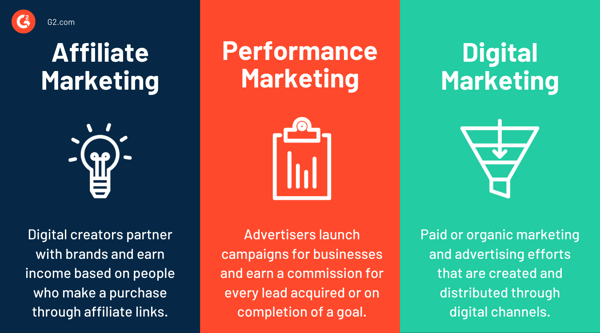July 16, 2021
 by Ninisha Pradhan / July 16, 2021
by Ninisha Pradhan / July 16, 2021

In an ideal world, you pay for exactly what you get. In reality, ad spend can vary from campaign to campaign due to many variables. Businesses find themselves paying the lion’s share of their budgets on advertising, nurturing, and finally, generating leads. It becomes a futile exercise if the leads aren’t of good quality.
But what if, instead of spending your hard-earned digital ad dollars on impressions and clicks, you could focus on the key performance indicators (KPIs) that generate actual business results – leads, conversions, and sales?
That’s the goal of performance marketing.
With senior leadership now extremely focused on digital return on ad spend (ROAS), performance marketing is a business model that guarantees that an agency or partner must meet client-defined metrics to fulfill their contract. Simply put, performance marketers must perform, or they don’t get paid.
Performance marketing continues to grow at a lightning pace. Throughout this post, we’ll delve into the different types of performance marketing, the benefits of leveraging this business model, and new trends that’ll bring you success.
Performance marketing refers to online marketing and advertising programs in which advertisers and marketing companies are paid only when a specific goal or desired action is completed. This action can achieve a lower-funnel level of conversion like a sale, lead, or click, or accomplish higher-funnel level objectives like views and impressions.
The advertiser and the agency dictate the cost of this performance-based business model on a cost-per-acquisition (CPA), cost-per-lead (CPL), or pay-per-click (PPC) basis. This can include any number of actions, including leads, registrations, demos, or sales. It’s a flexible form of digital marketing used on several platforms, like CPA networks, social media platforms, blogs, and mobile sites.
Performance marketing is data-driven. This type of marketing requires making decisions based on data, being analytical, and setting the right key performance indicators (KPIs) for specific teams to accomplish a goal. It also makes other forms of marketing more data-driven.
For instance, measuring the performance of an activity means that it’s quantifiable. Usually, when we think of tangible results in marketing, we immediately think about costs, downloads, or sales. Performance marketing focuses on these aspects, but it can be extended to areas of marketing that don’t necessarily conjure images of definite numbers, like brand marketing.
Since performance marketing is inherently goal-driven, measuring the success or failure in accomplishing business goals can be done for any task as long as an explicit goal has been set. This goal could be closing a sale, generating a lead, installing an app, registering for an event, subscribing to a newsletter, increasing clicks or decreasing bounce rates, or even the resulting amount of positive feedback generated from a design.
Having data at hand and associating it with every task brings about more transparency within the team and higher management. Viewing this data daily or weekly gives marketers a complete picture of the efficiency of their marketing efforts and the total costs incurred.
Tip: Pay-per-click services help businesses understand whether their paid advertisements are cost-effective or not.
While they may seem similar, affiliate marketing, performance marketing, and digital marketing are not the same. Affiliate marketing is a type of performance marketing, which is a subset of the larger picture. Digital marketing is used to facilitate performance marketing and affiliate marketing activities.
 Affiliate marketing refers to the practice of digital creators partnering with and promoting brands on their personal networks, such as a blog or social media platform. These affiliate marketers earn income based on the number of people who purchase merchandise through their affiliate links. Businesses use an affiliate program to promote a retailer’s products for a sales commission or a set payment for lead conversions.
Affiliate marketing refers to the practice of digital creators partnering with and promoting brands on their personal networks, such as a blog or social media platform. These affiliate marketers earn income based on the number of people who purchase merchandise through their affiliate links. Businesses use an affiliate program to promote a retailer’s products for a sales commission or a set payment for lead conversions.
However, performance marketing is the concept where marketing can be paid for and tracked based on the campaign’s performance. The success of a campaign’s performance isn’t limited to just a lead generation or the completion of a sale. It can also be other metrics, like views, clicks, mobile app installations, or subscriptions. The goal isn’t as narrow as it is for affiliate marketing.
Finally, digital marketing comprises marketing and advertising efforts that are created and distributed through digital channels. While affiliate marketing and performance marketing can be classified as marketing programs, digital marketing is more concerned with the methods of accomplishing a given marketing program.
Both performance marketing and affiliate marketing use digital marketing strategies to carry out their processes. Unlike the other types of marketing that are goal-specific, digital marketing is medium-specific.
In a utopian world, marketing is data-driven, efficient, optimized, and scaled up. But marketers have been asked to be data-driven for years now. No matter how much data you can associate a marketing activity with, at the end of the day, the person paying the bills calls the shots.
A stakeholder might be more concerned about hitting targets like deal closures, customer acquisition, or in general, seeing any direct impact on the revenue. This is where setting the expectations plays an important role, especially when performance marketing enters the conversation.
When marketers have a dialogue with the decision-makers of an organization on what functions and tasks should or shouldn’t be executed, it’s essential to set the following expectations to break common ground with higher management:
Here’s what marketers should do before creating a performance marketing strategy:
Stakeholders might not know what each marketing task comprises. For instance, a B2B company might not see an immediate need for an in-house designer. “Social media and social media posts aren’t our immediate goals right now,” they’ll say.
But design isn’t limited to a few colorful banners on social media. Assets, campaigns, sales decks, and other content forms will require designing. As a marketer, especially one who builds the entire team within the company, it’s crucial to lay out all the different hands involved in a marketing process and define each role until the last point.
The last thing you need is a stakeholder confused about what a particular team member does.
The immediate goals in any organization would be to hit numbers, increase revenue by a certain percentage, and plan for the next scale level But creating a good performance marketing culture within the organization requires a long-term vision that everyone works toward. There will be a point where you’ll reach a threshold, and it’ll be difficult to grow.
If a business has to be successful in the long term, building a brand should go hand-in-hand with performance marketing. While branding isn’t every stakeholder’s favorite word, especially when it costs money, it should be a long-term goal, and every individual’s work within a department should contribute to it.
Businesses can measure the impact of the brand by investigating the brand attributes, performing targeted campaigns, and later measuring its performance. Performance marketers can determine whether they’ve achieved the goal of eliciting emotion or creating a positive brand perception.
While setting targets for each task and channel is the obvious way to go, it might be in the business’ best interest not to set rigid targets. Different channels produce different results. Sometimes the results change every month within a particular channel.
If the CPL for a specific campaign was, say, $10, this figure could change for the next campaign. Campaign performances will differ based on public reception and what the competition is doing during the same period. An article could rank high on search engine results pages (SERPs) in one month and then drop in rankings after several weeks. While the quality of a marketing effort can be controlled, its performance cannot with so many variables involved.
Setting a strict target could actually hamper growth opportunities. If a campaign doesn’t hit the assigned target, it’d automatically be considered a failure. While campaigns have scope for improvements, the problem might also lie within the target itself.
A dangerous after-effect of having a rigid target is data being manipulated to show vanity metrics. These are hollow numbers that don’t serve anybody and end up being a waste of time and resources. Instead, targets should include a range and have a margin of error to account for any variable.
Furthermore, targets vary from industry to industry and region to region. A startup comparing results with a large enterprise makes no sense since the market share for each is different. Fine-tuning realistic targets for that industry and the organization’s current size is the way to go.
Performance marketing helps create a partnership between two parties: the advertisers (merchants or clients) and the publishers (affiliates or marketing agencies). This marketing method calls for the advertiser to pay the publishers when a specific action is completed.
Let’s consider an example of a business and a digital marketer.
What matters the most to a business are results. These results can be in the form of sales, leads, app installs, subscriptions, and so on. The end goal is for prospects to accomplish objectives that take them further down the funnel and ultimately convert them into customers. A digital marketer works on generating clicks, views, impressions, and even acquisitions. They’re regularly paying advertising platforms to accomplish these goals.
In a nutshell, the business seeks marketing qualified leads (MQLs), and the digital marketer is paying for views, clicks, and impressions. How does performance marketing constitute any of this?
In performance marketing, digital marketers or pay per click (PPC) experts pay for advertising while the business pays for the results. Depending on the campaign objective, the results could be anything ranging from an MQL to a subscriber.
Let’s say a business decides to pay an advertising service a fee of $10 for every MQL generated. This money doesn’t account for the cost of advertising, cost per click (CPCs), cost per impressions (CPM), or any additional charges for post reach and engagements. The business is least concerned about how the advertiser obtains the lead as long as qualified leads are generated. The entire cost of the advertising business space is borne by the digital marketer who looks after the conversion rate, click-through rate (CTR), and other quantifiable factors.
Suppose the digital marketer managed to obtain MQLs at $5 per lead. In that case, the primary profit generated by the marketer is the difference between the amount the client paid and the amount left after running the ads (in this case, the payoff is $10 - $5 = $5). This remaining margin acts as the commission for digital marketers. To maximize the profit, marketers will have to focus on reducing the CPL through optimized campaigns.
This is why performance marketing is a win-win for everyone. It delivers results to the business or clients, making them pay only through a cost per acquisition (CPA) or cost per action model. It also pushes marketers to optimize their ad spend and explore different ways to increase performance.
It’s worth noting that advertisers and publishers can set up different commissions for each of their individual campaigns following any of the performance marketing payment models listed below.
Performance marketing is a parent marketing method that encompasses several performance-based marketing styles. The most common performance marketing channels are listed below:
Affiliate marketing is a digital marketing strategy where brands partner with digital creators or an affiliate network to promote their products online. As a revenue-sharing method, affiliate marketing is where a retailer pays a commission to the affiliate when the affiliate’s referral traffic leads to a purchase or completion of a specific action.
Affiliate marketing helps alleviate the strain of identifying the right spokesperson or face for a cause. It’s unlimited in contrast to celebrity or influencer marketing.
Native advertising uses paid advertisements that match the form and feel of the editorial environment of the page they’re displayed on. Native ads are specifically designed to resemble a website’s color, layout, and theme and are placed with regular content to produce a higher conversion rate.
These ads are usually displayed in content recommendation widgets placed below or next to articles in news outlets or online magazines. For ethical reasons, these widgets go with a disclosure, like ‘Sponsored stories’ or ‘Paid content.’
With sponsored content, online publications and other sites embed content that closely resembles their own editorial content but is paid for by advertisers. The content is typically identified as “paid” or “sponsored” in some way. Sponsored content can be found on the top or bottom of SERP, on social media posts when an influencer collaborates with a brand, or through native ads.
Marketing a brand or products on social media to gain traffic and engagement through likes, shares, and clicks is known as social media marketing. It’s a large type of digital and performance-based marketing that encapsulates campaign creation and its launch, engagement with followers or users that follow a specific topic, trend, or hashtag, and encourages an open line of communication.
SEM is a paid effort to gain brand awareness through search engines. The unpaid version of search marketing is SEO (Search Engine Optimization), where a brand naturally incorporates keywords and phrases often searched by the target audience.
With SEM, brands use search advertising software to choose target keywords and build ads that appear at the top of search engines above the organic results. SEM can be of two types: product listing ads (PLAs) or text-based ads.
There are many benefits to running performance marketing campaigns, including:
Performance marketing is a hundred percent measurable. The affiliate software or network you use logs your campaign metrics and allows you to determine when traffic is converting or if your affiliates are sending low-quality traffic.
One of the reasons digital marketers utilize performance marketing is to easily track performance and give credit to the appropriate referring source. The industry is expected to see advancement in these areas as technology evolves.
Some of the most common methods of attribution include:
Multi-touch attribution can be tracked through position-based allocation, time decay, and linear attribution.
Because organic and paid campaigns complement one another and drive higher conversion rates when used in tandem, performance marketers always or often plan performance campaigns to run simultaneously with organic efforts.
In addition to better tracking, online performance marketing is a low-risk option, as payment isn’t made until after the sale or conversion. Performance marketers are skilled at advertising efforts and can monitor the campaigns every step of the way, tweaking the ad whenever it seems to risk failing.
The marketing tactic also offers a high Return on Investment (ROI), which is less risky for the merchant. Businesses only have to pay for what they request, and performance marketers can set up an estimate that includes the profit potential.
By setting the commission rate for affiliates, merchants can determine the exact profit margin without any surprises. Additionally, businesses can focus on what they do best without spreading their efforts across multiple activities.
While a merchant may only have the budget or time to concentrate on particular forms of marketing, an affiliate will use various methods to promote products.
Performance marketing allows the merchant to take advantage of extended marketing methods like:
It’s always better to have someone else say how fantastic your brand is than to claim it yourself. Performance marketing effectively incorporates third-party validation when influencers and affiliates promote and praise your products.
It’s not all hunky-dory in the digital advertising world.
The internet marketing space consists of many avenues where people can make money online. Wherever money flows, there’s bound to be some sleazy practices being adopted to exploit what the internet has to offer. These practices have resulted in black hat activities and have contributed to the ugly side of the online space.
There’s a lot of spam present in digital marketing and affiliate marketing channels. An example of this is regurgitating links across the internet without rhyme or reason, driving cheap, low-quality traffic, and making a quick buck out of it. Large digital platforms despise these kinds of practices and work toward penalizing such activities, even going as far as shutting a page down.
Digital platforms and channels like Google use robots or ‘bots’ to crawl each page and examine each link. Commonly, people in the digital space say that “robots are coming to take you out.” But these bots are meant to keep the good and weed out the bad and the ugly. They help marketers constantly perform better by ensuring white hat tactics and healthy practices are being adopted.
Robots will reward those who add value for the audience and punish those who don’t. This is why performance marketing should be “robot-friendly” or, in other words, promise growth through continued efforts to provide quality.
Let’s look at some of the ways where marketers can improve their performance marketing function:
The key to a successful ad is creative development. But how do you know which ad format and which creatives will stick and go the distance? By testing.
To optimize your conversion rate, you need to know what users are more likely to click on. Use the A/B testing method to tweak your marketing and create an effective campaign.
The idea of the A/B test is to create two very similar marketing campaigns (say, an email campaign) and change only one variable between the two (like the subject line, image, headline, etc.). Measure which email is opened more has a higher click-through rate and ultimately drives your audience further down the sales funnel.
Most marketers do test out images and headlines, but testing the angle is where you often find the most significant wins. An advertising angle focuses on the message being spread as opposed to the medium. Angles make campaigns more relatable to the audience by defining and achieving objectives and finding the best way to influence customers into agreeing.
The beauty of performance marketing or working online, in general, is that you don't have to do all of the work yourself. Keeping the focus extremely specific prevents marketers from spreading themselves too thin and diluting their efforts.
If your goal is to generate MQLs and you’re adept at campaign promotion, partner up with someone skilled at campaign creation. With combined forces, the results are optimized.
As the internet continues to grow, so do the types of platforms. Existing platforms will continue to scale and add more features to their current line up while newer platforms will mushroom in the years to come. The trick is to be on top of any new updates and trends that may come up.
It might not be feasible to keep track of everything going on, but segmenting the team to focus on subsets or smaller channels helps performance marketers collaborate, share, and diversify their existing portfolio of services.
Performance isn’t limited to a specific region; it has the potential to scale to newer heights. When a business wants more results (quality and quantity) and the current area has been exhausted, it’s time to look at other regions and demographics. Keeping this for the last minute hurts a performance marketer’s chances since they have to compete with others in a new geographic area, and they’re a bit late to the party.
To get around this issue, performance marketers should have a step-by-step strategy for scaling up. As soon as a sizable chunk of the market has been captured, performance marketers should conduct research on the target audience in different regions, observe what works and what doesn’t, and be better prepared when a client requests results from different geographies.
Even with a ton of high-quality traffic on your site, you won’t see the traffic convert without an effective landing page or offer. Create a strong landing page by:
Performance marketing is based on data – how well campaigns perform and how to optimize them.
Track as many elements of a campaign as you can, like mobile visitors vs. desktop, click-through rate, time on site, bounce rate, and traffic sources. With customer data platforms, marketers have access to user data in real-time. This will help you develop a highly effective marketing plan that specifically reaches your desired audience with the right message at the right time.
Performance marketing is the next big step in digital marketing. It’s collaborative, fast-paced, and has scope for constant optimization. It keeps real business impact at the heart of its strategy, measured by action-focused metrics above anything else.
Performance marketing is a way to expand your marketing’s scale and distribution while building mutually beneficial relationships with affiliates and agencies alike. As more money is poured into digital marketing, the demand for more accurate data and a higher ROI will only continue to grow.
Ready to learn more? Discover how market intelligence can help you crush your competition.
Ninisha is a former Content Marketing Specialist at G2. She graduated from R.V College of Engineering, Bangalore, and holds a Bachelor's degree in Engineering. Before G2, Ninisha worked at a FinTech company as an Associate Marketing Manager, where she led Content and Social Media Marketing, and Analyst Relations. When she's not reading up on Marketing, she's busy creating music, videos, and a bunch of sweet treats.
Multi-channel marketing allows you to engage with your audience where they are, all at once.
 by Sagar Joshi
by Sagar Joshi
In this post, we’ll break down the difference between PPC and CPC, describe how they work and...
 by Kevin Kapezi
by Kevin Kapezi
People increasingly view YouTube on mobile devices rather than desktops, and Google has...
.jpg) by Adam Torkildson
by Adam Torkildson
Multi-channel marketing allows you to engage with your audience where they are, all at once.
 by Sagar Joshi
by Sagar Joshi
In this post, we’ll break down the difference between PPC and CPC, describe how they work and...
 by Kevin Kapezi
by Kevin Kapezi


